Introduction
The second Sherlock Holmes movie from Universal was, like the first, a wartime propaganda piece. By now they had settled into the formula of lifting some elements from the Sherlock Holmes stories (the opening lifts pretty heavily from “His Last Bow”, the overall plot is similar to that of “The Bruce-Partington Plans”, and the dancing men code from “The Dancing Men” is central to the plot). However the key thing this film would contribute to the series was the first appearance of Dennis Hoey as Inspector Lestrade.
It’s definitely fair to say that modern perceptions of Lestrade owe far more to Hoey’s portrayal than they do to the Holmes canon. In the novels, the primary characteristics of Lestrade are his working class background, tenacious nature and lack of patience with Holmes’ long-winded bouts of reasoning. However, he was always portrayed as competent and willing to grant Holmes the benefit of the doubt. The modern view of Lestrade as the bumbling fool dependant on Holmes to pull him out of the mistakes he is about to make was born right here, with Hoey’s performance, but has become so engrained in the public consciousness that most people wind up reading the books through this lens. A frequent source of comic relief, the London-born Hoey’s Lestrade became the fourth recurring character in the series (after Holmes, Watson and Mrs Hudson) to be played throughout by the same actor, appearing five more times after this, as well as appearing in several of the Universal horror films that were filmed at the same time.
The film itself is also notable for the return of Moriarty, played by Lionel Atwill (who had played the villainous Dr Mortimer in Hound of the Baskervilles). He had aged quite considerably between the two roles, despite them being only three years apart, and few would recognise the slim dapper Dr Mortimer in his corpulent, balding (yet definitely menacing) Moriarty. In fact he had been 54 when he played Mortimer and had looked extremely young for his age. A messy sex scandal and perjury charge in the intervening years had taken their toll, and his health never really recovered. He would die three years later in 1946, a sad end for a talented actor.
Synopsis
“Switzerland!” declares the opening splash. In a cafe, two German men are joined by an elderly bookseller, who tries to sell them “the complete works of Wilhelm Shakespeare, an old German writer”. In truth, the two men are spies, and the bookseller comes with “orders from Berlin. Dr Tobel must be across the border by dawn.” The two men are dubious, but the bookseller insists that the new bomb sight Dr Tobel has developed is so important that a way must be found. Fortunately, he has secured an introduction to the doctor and will use it to visit him. As he leaves, he warns them that he has heard that a British agent named Holmes is in the area…
Tobel allows the bookseller in, whereupon the bookseller reveals that he is actually Holmes. Tobel burns his papers while Holmes explains his plan – Tobel’s servants will act as decoys while they escape. The plan works – the two servants lead the Germans away, while Holmes and Tobel steal their car and escape to a private airfield, where an RAF plane whisks them away to London.
The London they arrive in is the London of the Blitz, illustrated when Tobel stumbles over some debris in the darkness of the blackout. The two arrive at 221B Baker Street, where Watson surprises them with a revolver and phones Scotland Yard, before Holmes can let him know who he actually is. Watson recognises Tobel’s name as that of a prize-winning physicist (clearly this leading to his bomb-sight design). Holmes goes out to give his report, while Tobel waits for Watson to doze off and then makes a phone call to arrange a meeting, before sneaking out.
Holmes meets with a British higher up, Sir Reginald, where they discuss how vital to the war effort the new bomb sight could be. Meanwhile Tobel makes his way to an apartment building, unaware that he has been followed. He meets with his fiancée, Charlotte Eberli who is played by Kaaren Verne (a German actress who had fled the Nazi regime in 1939, and who appeared in a large number of propaganda pictures). He gives her a mysterious message, consisting of a series of drawings of dancing stick figures, and tells her to keep it safe in case anything happens to him. As he leaves the building, something almost does happen to him – the people who had been following him try to kidnap him, only to be foiled by a passing Air Raid Warden.
Holmes returns to 221B Baker Street to find Tobel missing. His panic is averted when Tobel appears, although the injuries he suffered in the attempted kidnapping are clearly apparent. Holmes then deduces that Tobel had gone to see a woman – “Five feet tall, blonde, very affectionate” – before asking if he had seen his assailant. Tobel had not, but he noticed the attacker smelt strongly of opium.
The next morning, Tobel’s bomb sight is tested on Salisbury Plain. We learn that it involves “the use of three sonic beams”, thus pointing to some actual research by the writers, and pegging the bomb sight as some form of radar-guided system. Radar was reasonably well known at the time, although the exact details of its military applications were of course secret. The pin-point accuracy of Tobel’s bombsight leaves the military generals and cabinet ministers thoroughly impressed. Sir Reginald then asks Inspector Lestrade (who is, somewhat inexplicably, present at this top secret demonstration, as are Holmes and Watson)about the security arrangements for transporting Dr Tobel to his office. A few panning shots of London and a quick blast of “Rule Britannia” later, we are at the office (which bears a striking resemblance to the meeting room of the “Inner Council” in Voice of Fear). There, Dr Tobel outline his plans for the manufacturing of his bombsight. Rather than put it in to mass production, he intends to supervise the construction himself to keep it secret, and refuses to reveal his plans. The government, unable to budge him on this, agree.
Tobel meets with Professor Hoffner, another Swiss scientist, and hands over a package containing a portion of his bombsight along with the instructions on how to duplicate it. He explains that he has divided it into four parts, ach useless without the other three, to be manufactured by four experts. None of them will know who the other three are, and only he, who will assemble the components, will know who the four scientists are.
Holmes and Watson receive a report from Lestrade that Tobel has gone missing. They meet Sir Reginald at Tobel’s hideout, where they determine that he has been missing for quite some time, and that the bombsight is gone. Holmes notices a smell of perfume in the air, and deduces that the mysterious woman who Tobel had gone to meet the night he arrived in London must be involved. He has Lestrade trace a call made from Sherlock’s own phone that night, realising that Tobel would have called ahead.
They meet with Charlotte, though at first she is evasive. Partway through the conversation, the phone rings with the news that her car has been found abandoned by the side of the road, and she realises that Tobel must have been kidnapped. She hands over the envelope that Tobel left with her for safekeeping, only to find that it contains nothing but a note saying “We meet again, Mr Holmes!” They swiftly determine that the only one who could have stolen the message was an electrician, who they recognise from the description as Moriarty.
Holmes disguises himself as a former employee of Moriarty (an Indian sailor named Ram Singh who he knows is still in jail) and heads to a series of rough pubs (the “Star and Dagger”, where he threatens to glass someone, followed by the “Golden Hawk”, a pub so crooked that the 20 isn’t at the top of the dartboard, and then the “Black Swan” and the “Old Bottle”), before he is approached by a peg-legged ruffian who, fooled by his disguise, offers to sell him the location of Moriarty, the man who sold him out and had him jailed. Holmes plays along, but insists that Peg Leg (actual name in the credits) comes with him. Peg Leg takes him to a carpenter’s shop, where the carpenter claims that Moriarty is dead, a claim “Ram Singh” vigourously contests – until the matter is rendered moot by the appearance of Moriarty himself, who sees through Holmes’ disguise instantly. (Holmes claims that it was never intended to fool Moriarty, just his minions.) Holmes appeals to Moriarty’s patriotism, but Moriarty remains purely mercenary in outlook – he intends to sell the bombsight to the Germans for more money than he has made on all his previous crimes combined. He also intends to see that Holmes cannot interfere, but rather than shoot him, he intends to seal him inside a chest loaded with iron weights, with plenty of time to contemplate being thrown overboard once Peg Leg and his accomplice have their boat out of sight of land.
It turns out that a beggar we had seen following Holmes earlier was actually one of his agents, who has gone to fetch Lestrade and Watson to rescue him. (Luckily for him this is earlier in the series – if this happened towards the end, when these two were firmly nailed as bumblers, he would be doomed.) Lestrade insists that Moriarty is dead, possibly a nod to his earlier appearance in the series. They spy Peg Leg and his confederate carrying a chest out of the shop and confront them, but are initially fooled by the false shelves in the chest. However as the two men leave, they realise that the chest seems far too heavy for the apparent contents and give chase, losing the two men, but recovering the chest and rescuing Holmes.
Back at Charlotte’s apartment, Holmes realises that he can recover the code from the impression left on the notepad Tobel had used to write it. He does so (using UV photography, a safer method than “rubbing a pencil over it”) to reveal a message written in a code of “dancing men” that he and Watson both recognise from an old case. Watson assumes that it is a simple substitution cipher, like the previous one they encountered, but he fails to interpret it. Holmes then reveals that he believes that marks at the top of the paper indicate that they should advance the first letter by one place in the alphabet, the second by two and the third by three. (Of course, he then applies this to Watson’s interpretation that was based on an incorrect distribution, which makes no sense, but I guess we can let that slide. In fact, it’s slightly unclear if Watson did that or if he simply looked up the original cipher, in which case this would make more sense.) They decipher the first line and realise it is a name and an address, and quickly figure out the second and third lines as well. The fourth, however, defeats them – it appears to be using a different cipher. Still, Holmes quickly deduces Tobel’s plans and they set off to try and get to the other three scientists before Moriarty can get to them.
Unfortunately, Moriarty has had the cipher for a lot longer than them, and they find the police already on the scene, as the first scientist was murdered several hours ago. Holmes guesses that the other two whose names he could decipher are also dead, a hypothesis Lestrade confirms with a phone call. Their only hope is that Moriarty has also failed to decipher the fourth name.
And indeed he has not, as we see Moriarty torturing Tobel to try to get him to reveal the name of the fourth man, with no success. Holmes, however, has a breakthrough prompted by a chance remark from Watson, and realises that the fourth line has been written in mirror image. He decodes it to get the name of Hoffner – the scientist we saw earlier meeting with Tobel. Moriarty, however, decodes the name as well – spilling a glass of water over a facedown copy of the note, and then seeing the figures show through the paper reversed. He sends his men off, with instructions to bring back Hoffner alive – if Tobel does not recover from the torture then Hoffner is one of the few other men who could reverse-engineer the bombsight.
Moriarty’s men surprise Hoffner and take him and his portion of the bombsight to a dockside lair, where Moriarty is preparing to meet a German submarine. Moriarty opens the box containing the bombsight, only find a note reading simply “We meet again, Professor!”. The supposed Hoffner is actually Holmes in disguise, and Hoffner is safe. Holmes, however, quite definitely is not.
Hoffner (the real Hoffner) meets with Watson and Lestrade, and explains to them that Holmes took his place, and he attached a device to the German car to drip luminescent paint. (While this is clearly for the viewer’s benefit, it does create the image of Holmes getting up and rushing out without bothering to tell anyone where he is going.) They set off to track Holmes’ abductors to Moriarty’s lair.
Moriarty offers Holmes his choice of methods of death – poison, bullets or a knife. Holmes laughs at these methods, and taunts Moriarty with his lack of originality. He offers offhand the alternative, crueller, method of draining out his blood, drop by drop, so that he should feel his life ebbing away. Moriarty then reveals that he has a full operating theatre on the premises, having used this base as a field surgery for his men rather than risk them going to a public hospital, so he can easily implement Holmes’ suggestion.
Watson and Lestrade race to the lair, as Moriarty gloats over the dying Holmes. Holmes remains defiant, as Lestrade and Watson sneak into the building. They stop Moriarty before he, impatient with the slow progress of the bloodletting, can finish Holmes off with a pistol. Moriarty manages to escape, and Lestrade and Watson assume he is going for the speedboat containing Tobel and race off to stop him, leaving a weakened Holmes staggering after. They recover Tobel, while Holmes makes his way to a secret passageway he had seen before, intercepting Moriarty as he tries to escape. Moriarty explains that he had not been worried about Holmes knowing of the passage as it was trapped, so that anyone who followed him would die. Watson’s arrival gives Moriarty the distraction he needs and he makes a break for it through the tunnel – only to fall victim to his own trap, which Holmes had already activated.
We close with the characters gathered together, watching a flight of RAF bombers armed with Tobel’s bombsights setting off. Holmes quotes patriotically from Richard II as the film ends.
Conclusions
Sherlock Holmes and the Secret Weapon set the tone for many of the films that would follow. Motifs from the stories (the dripping trail, the sinister sailors, the disguise as an old bookseller fooling Watson) mixed in with a relatively straightforward adventure plot, this would be the standard template for most of the films to come. As such, though it’s a relatively typical example of the series (apart from the propaganda trappings) it still holds a special significance for being first – and for introducing Lestrade, who would appear in half of the films from Universal. Moriarty, too, would return (his death here deliberately ambiguous, although they would not play that up on his return) but would be played by yet another actor. But that’s in the future. Next time, in the last of the three propaganda films, Sherlock Holmes goes to America.

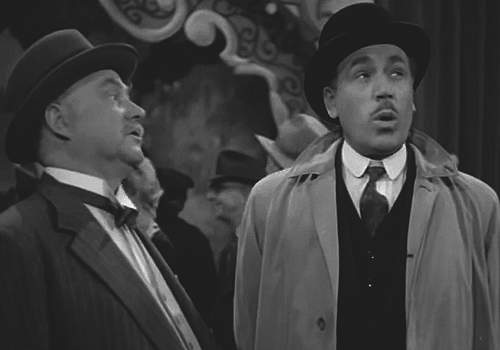
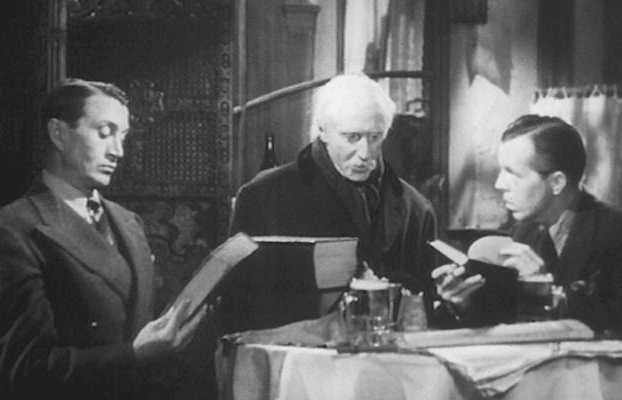
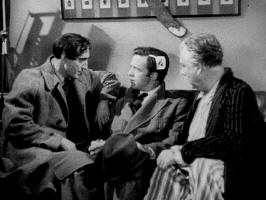
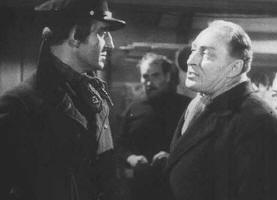
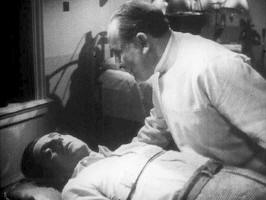
Pingback: Today’s Scribbling: Movie Review – Sherlock Holmes and the Secret Weapon (1943) – Daily Scribbling